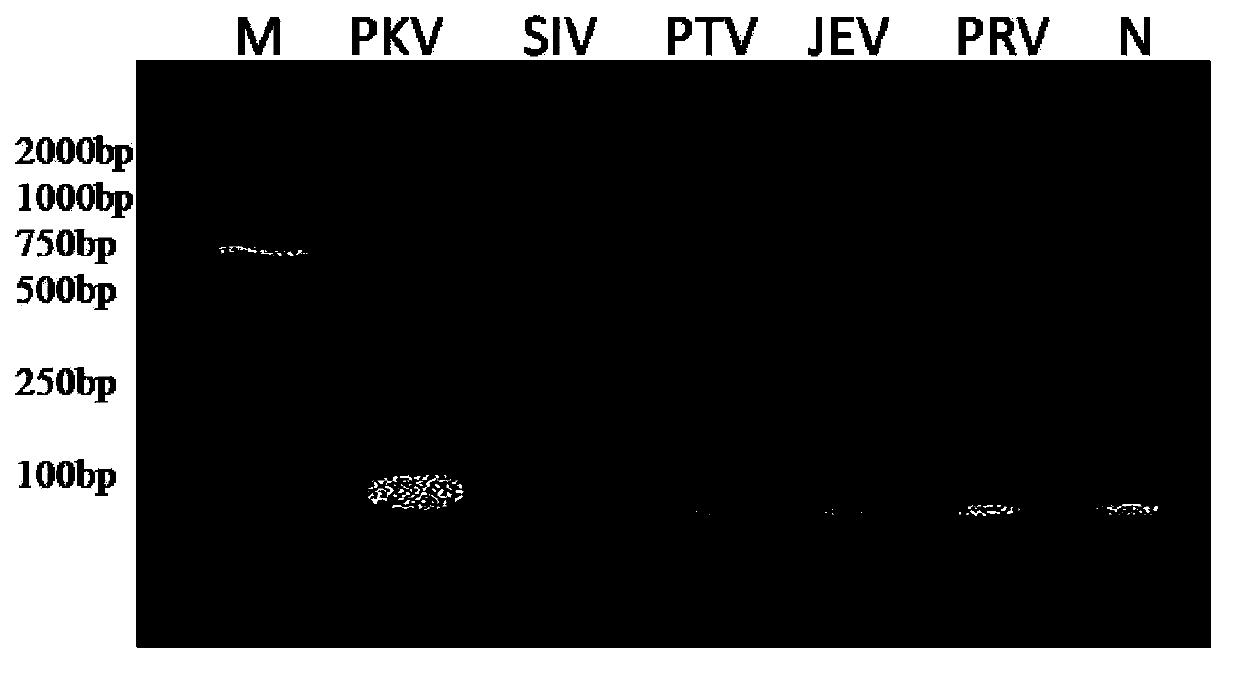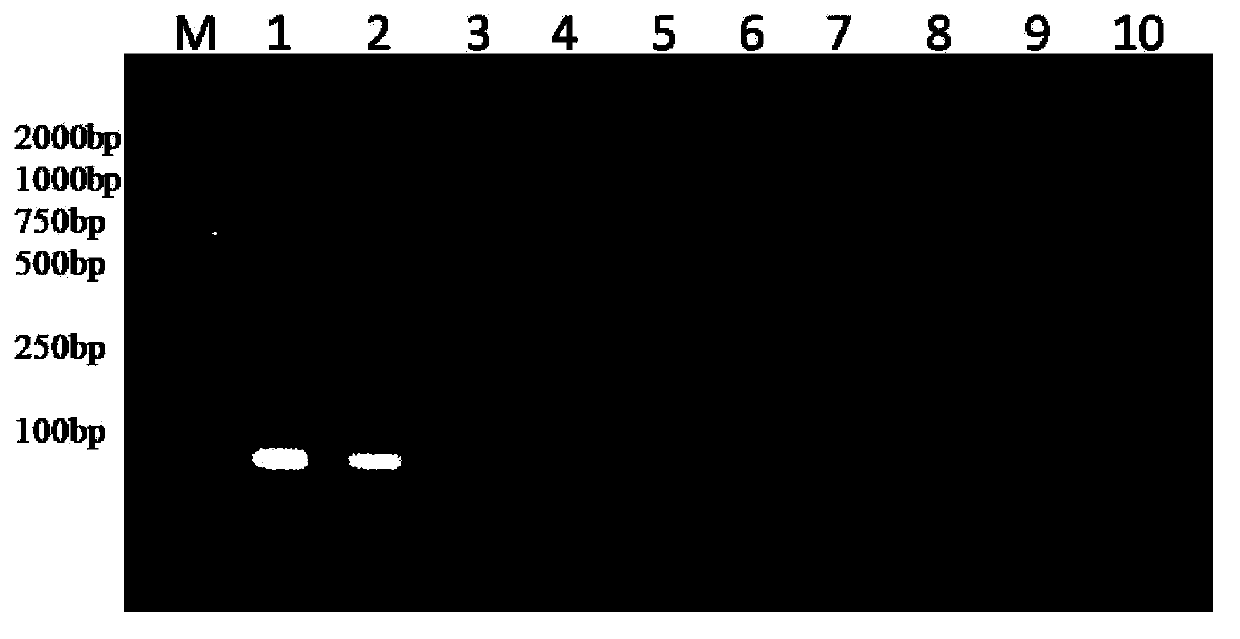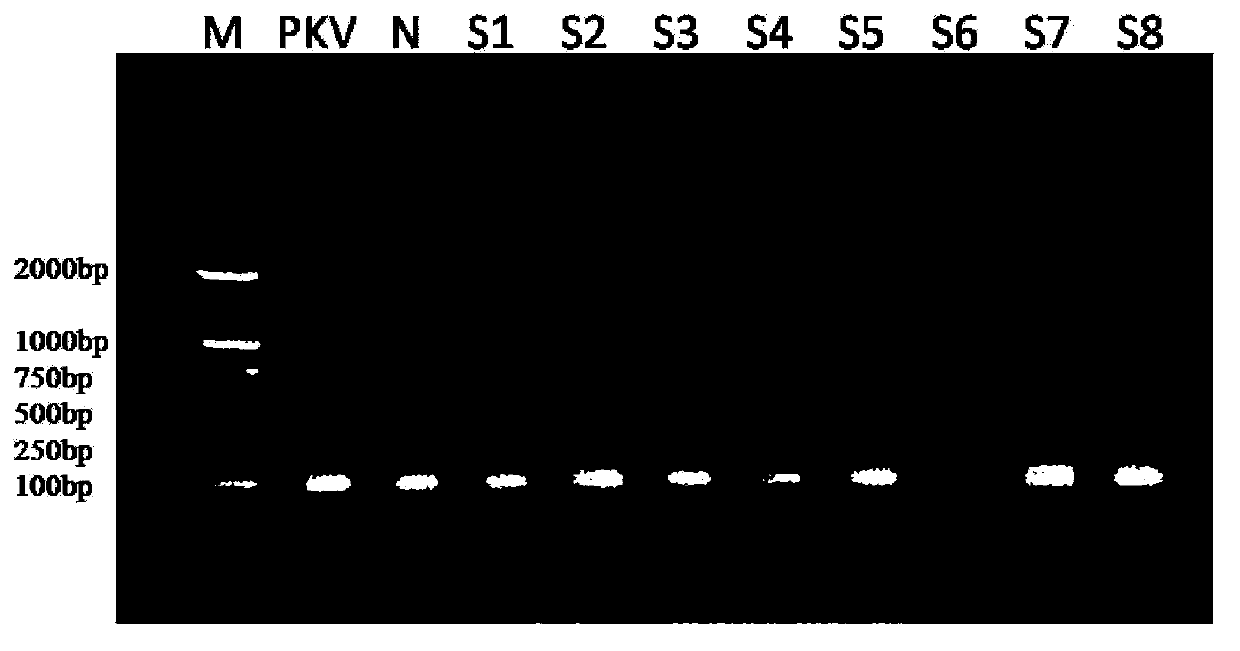Nested RT-PCR(reverse transcription-polymerase chain reaction)kit and method for detecting porcine Kobuvirus
A technology of RT-PCR and kit, applied in the field of genetic engineering, to achieve the effect of good specificity, low cost, and easy determination of results
- Summary
- Abstract
- Description
- Claims
- Application Information
AI Technical Summary
Problems solved by technology
Method used
Image
Examples
Embodiment 1
[0054] The design of embodiment 1 specific primer
[0055] Specific primers were designed for the conserved sequence of porcine Kobu virus S-1-HUN strain gene (GenBank accession number EU787450), as shown in the table below, and specific nested PCR primers were synthesized according to the following sequence. Dilute the primers with DEPC-H2O to 20pmol / L, and store them at -20°C for later use.
[0056]
[0057] The establishment and optimization of embodiment 2 amplification system
[0058] 1. Overcoat PCR amplification reaction system and amplification program optimization
[0059] Using the cDNA obtained at RT as a template, optimize the 50 μL coat PCR amplification reaction system. The reaction system consists of 10×PCR Buffer (Mg 2+ plus) 5μL, 2.5mM dNTP Mixture4μL, 5U / μL Taq enzyme 1μL, 20pmol / μL outward primer 1μL each, ddH 2 O33~35μL, cDNA3~5μL composition. The amplification conditions are: ①94~95°C, 3~5min, ②93~94°C, 35~45s, ③58~60°C, 30~40s, ④70~73°C, 35~45s, 3...
Embodiment 3
[0062] Embodiment 3 specificity and sensitivity test
[0063] Using the optimized system and amplification conditions described in Example 2, get porcine Kobu virus (PKV) positive samples, swine influenza virus (SIV), porcine Jieshen virus (PTV), porcine Japanese encephalitis virus (JEV), RNA was extracted from 6 samples including porcine pseudorabies virus (PRV) and negative control (N), and after reverse transcription, nested PCR was used to test the specificity of the kit. Among them, RNA extraction reagents include Trizol, chloroform, isopropanol, 75% DEPC-ethanol, DEPC-H 2 O; The conditions of nested PCR are as follows: the amplification conditions of MIXⅠPCR are: ①95°C, 3min, ②94°C, 40s, ③59°C, 30s, ④72°C, 40s, steps ② to ④, a total of 35 cycles, ⑤72°C, 8min; The conditions for MIXⅡPCR amplification are: ① 95°C, 3 min, ② 94°C, 30s, ③ 59°C, 30s, ④ 72°C, 35s, steps ② to ④ for a total of 30 cycles, ⑤ 72°C, 8min.
[0064]Nested PCR results showed that only porcine Kobu vir...
Embodiment 4
[0066] The assembly of embodiment 4 kits
[0067] The preparation of kit components is completed according to the three parts of total RNA extraction, RT and nested PCR. The data and reagent composition provided below are the reagents required for a single nested RT-PCR detection:
[0068] (1) Total RNA extraction (stored at 4°C)
[0069] Sample lysate tube: Trizol750μL;
[0070] Chloroform tube: 200 μL of chloroform;
[0071] 75% ethanol tube: 800 μL of 75% DEPC-ethanol;
[0072] Isopropanol tube: 600 μL of isopropanol;
[0073] DEPC-H 2 O tube: 11 μL;
[0074] (2) Reverse transcription (RT) (stored at -20°C)
[0075] RT master mix tube: 2 μL of 10× reverse transcription buffer, 25 mM MgCl 2 4 μL, 10 mM dNTP 2 μL, 40 U / μL RNasin 0.5 μL, 0.5 μg / μL random primer 2 μL, 25 U / μL MV reverse transcriptase 1.5 μL, DEPC-H 2 O 3 μL.
[0076] (3) Nested PCR (stored at -20°C)
[0077] Overcoat PCR reaction solution tube (MIXⅠ): 10×PCR Buffer (Mg 2+ plus) 5 μL, 2.5 mM dNTP Mixt...
PUM
 Login to View More
Login to View More Abstract
Description
Claims
Application Information
 Login to View More
Login to View More - R&D
- Intellectual Property
- Life Sciences
- Materials
- Tech Scout
- Unparalleled Data Quality
- Higher Quality Content
- 60% Fewer Hallucinations
Browse by: Latest US Patents, China's latest patents, Technical Efficacy Thesaurus, Application Domain, Technology Topic, Popular Technical Reports.
© 2025 PatSnap. All rights reserved.Legal|Privacy policy|Modern Slavery Act Transparency Statement|Sitemap|About US| Contact US: help@patsnap.com



